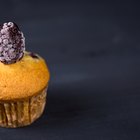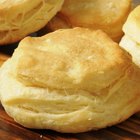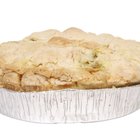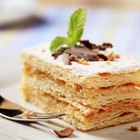bhofack2/iStock/GettyImages
Baking powder biscuits are known for their light, fluffy layers. This quintessential American food seems simple to make, but a few missteps ends in hard, flat discs, suitable for nothing more than the trash bin. Pay close attention to the freshness of your leavener and the temperature of your ingredients. Avoid overmixing biscuits and you'll have success. Once you've mastered the art of making biscuits, you'll find them a cinch to make.
The Type of Leavener
Most biscuit recipes rely on baking powder to leaven them. Baking powder is baking soda that has been combined with an acid, such as cream of tartar. If your biscuits aren't rising, it might be due to a problem with your baking powder. Make sure you use enough baking powder -- typically 1 teaspoon for each cup of flour in the recipe. You should also make sure the baking powder is fresh. It begins to lose its effectiveness three to six months after opening, and should be replaced at least once per year. Most baking powders on the market today are double-acting, meaning they contain two acids. One acid begins working right away to make bubbles, while the other acid begins working in the oven. Because of this, baking powder is more stable than it used to be. Still, you should try to get the biscuits in the oven as quickly as possible.
Ice-Cold Ingredients
Another reason your biscuits might be flat is because of the temperature of the ingredients. While you typically cream room-temperature butter with sugar and eggs when making quick breads and cakes, you need a different approach when making biscuits. When making biscuits use diced or grated bits of ice-cold butter, as you would when making pie crust. As the cold butter melts in the oven, it forms pockets of steam in the dough, which creates those tender layers in the oven. If the butter is warm, you won't get flaky results. Make sure any milk, buttermilk or cream you use is cold, too.
Oven Temperature
Although most baked goods are cooked at a temperature between 350 and 375 degrees Fahrenheit, biscuits need a more radical approach. Crank the heat up to 450 degrees F. and allow the oven to fully preheat. This high heat causes the biscuits to rise rapidly and become golden brown.
Mixing Techniques
One final thing to consider is how you mix your biscuits. First, sift together all the dry ingredients so the baking powder is fully incorporated with the flour, sugar and salt. Use a light hand when you're adding the butter. You can use a food processor, a stand mixer or a pastry knife, but work the butter just until it's coarsely mixed. At this point, the dough should have a pealike texture. Keep this light hand as you add the liquid and knead the dough. If you mix too vigorously at any point, you'll toughen the dough and it won't rise as well. When you roll the dough out, roll it evenly to a thickness of 3/4 to 1 inch. If you roll it too thin, you're not going to get the tall, gorgeous biscuits you're seeking.
Related Articles

What Temperature to Cook Scones?

Do You Have to Bake Your Biscuit Dough ...

How to Get Pizza Crust to Brown

Softened vs. Melted Butter When Baking
Can I Store Biscuit Dough Overnight?

How to Make Bread Chewy

Will My Dumplings Get More Airy As They ...
Why Do My Biscuits Turn Out Hard and ...

How to Make Homemade Biscuits With Water

How to Make a Tall Fluffy Cheesecake

What Causes Cupcakes to Fall?

How to Make Dinner Rolls With a ...

What Temperature to Cook Scones?

How to Make Scones

How to Make Southern Buttermilk ...

Does It Matter if I Substitute Baking ...

Can Self Rising Flour Substitute for ...

How to Use Guar Gum to Replace Gelatin

How to Pre-Bake Puff Pastry

What Is Docking Used for in Baking?
References
Writer Bio
Julie Christensen is a food writer, caterer, and mom-chef. She's the creator of MarmaladeMom.org, dedicated to family fun and delicious food, and released a book titled "More Than Pot Roast: Fast, Fresh Slow Cooker Recipes."